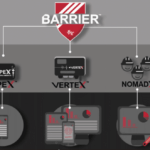As we’ve written about before, Industry 4.0 is here. This new industrial revolution is different from previous ones in one significant way: it’s all about using technology to streamline the industry. With a network of intelligent tech, Industry 4.0 allows computers and networks to communicate and essentially make decisions based on the data they collect via the internet.
The Industrial Internet of Things (IIOT)
If you’re new to the concept of IIOT, it’s mostly the use of computers, devices, and objects to collect, share, and interpret data within industrial applications. We’ve had IOT (Internet of Things) impacting consumer applications for years; our smartphones, our computers, our smart home devices, and so on. However, with Industry 4.0, we’re seeing a significant shift in a variety of industrial sectors to the adaptation of IIOT. This includes equipment and systems that offer automation, monitoring, cloud data storage, predictive analytics, and more. Whether mining, foundry, manufacturing, processing or another industry, IIOT is likely already impacting your operation. Here are just a few ways this new “movement” is benefitting operations of all kinds.
Cloud data storage
If you have a widespread, national, or global operation, imagine what “the cloud” could do. Through connected devices and equipment, you could collect and store data accessed from anywhere — you’re no longer tied to location. Of course, these systems are very robust and offer exceptional cybersecurity, and the use of the cloud means that you can aggregate other data and assess your systems from anywhere in the world. These systems also collect historical data that can advise future work, repairs, and operations when used with other IIOT tools we’ll discuss later.
Automation
Automation can take many forms, including automated batch processing, automated supply chain, automated shipping, and more. Mining automation means higher rates of reclamation, fewer operational bottlenecks, and increased safety by limiting manual labor needs. For foundry, automation means quality-controlled castings, less damaged material, and faster processing. For batch processing, it means more accurate sorting, less contamination, and more streamline processing than before.
Equipment and IIOT devices can be set to operate and “communicate” in ways that ensure your facility is operating at maximum capacity, with less oversight and fewer inconsistencies.
Monitoring

Today’s IIOT means that even smartphones can be connected to the system, so you’ll always receive notification of a problem. General Kinematics offers the VERTEX™ Monitor, which allows users to measure the performance of their vibratory equipment as well as monitor multiple pieces of equipment over time and receive alerts when there is an issue.
Environmental and quality control
IIOT and the use of predictive tools are quite useful in mining applications, where workers need to assess environment and emissions quality before, during, and after their work. Foundries can use similar control tools to stabilize the temperature, casting ingredients, and tumbling process for their materials. IIOT devices can also be used to help miners complete environmental impact assessments or plan out their mine rehabilitation projects, based on environmental readings, before getting started.
Artificial intelligence
AI can seem like science fiction, but in today’s IIOT world, it’s anything but. These smart-systems collect massive amounts of data (in the cloud) and run scenarios against that data to predict outcomes that advise new solutions. This means processing facilities can have smarter sorting, mining operations can have better reclamation rates, and foundries can have standardized quality control. It also means that the equipment they use is maintained and improved upon, all by allowing predictive analytics to guide operations.
IIOT can be as small-scale or large-scale as fits your operation, and the use of these tools should of course, always be weighed against their ROI. In general, however, IIOT has proven to reduce downtime, improve productivity, and even stabilize costs across industries.
The Internet is the Future of Industry
Of course, all of the benefits of IIOT mentioned above wouldn’t be possible without the internet. That’s why upgrading equipment, installing monitoring devices like VERTEX™, and investing in automation and monitoring systems all connected via the internet is becoming a significant focus for mining, foundry, processing, and other operations.
To ensure that you’re getting maximum ROI and benefits from this new push to IIOT, it’s essential to use equipment and devices that are top-of-the-line. General Kinematics is committed to innovation and improvement, and we are revolutionizing uptime across multiple industries. If you’re ready to bring IIOT to your facility, and to benefit from cloud connections, stress-free monitoring, and automation, connect with GK today.







